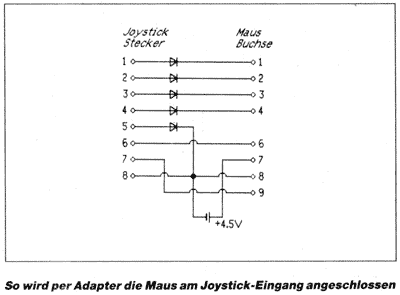Difference between revisions of "Atari-ST mouse adapter"
m (→Software supporting the ST-Mouse: alphabetically sorted) |
m (→Software supporting the ST-Mouse: expanded & sorted) |
||
| Line 49: | Line 49: | ||
* [[G-Paint]] 2.0 (Günter Radestock) | * [[G-Paint]] 2.0 (Günter Radestock) | ||
| − | [[Category: | + | [[Category:DIY]] [[Category:FutureOS]] [[Category:Input Device]] [[Category:Peripherals]] |
Revision as of 20:52, 4 April 2011
This adapter allows to connect Atari ST mouse and trackball.
Contents
Schematic
The schematic was released in german magazine "Schneider Magazin, 07/1988", apparently using 5 diodes and a 4.5V battery.
Aside from Atari-ST mice, the circuit should also work for Amiga mice, which are basically the same, but with XA/XB/YA/YB connected to other pins, which could be resolved at software side (or at hardware side).
CPC Joy Port Atari-ST Mouse Amiga Mouse JoyUp Pin1 --|>|------------- Pin1 XB Pin1 YA JoyDown Pin2 --|>|------------- Pin2 XA Pin2 XA JoyLeft Pin3 --|>|------------- Pin3 YA Pin3 YB JoyRight Pin4 --|>|------------- Pin4 YB Pin4 XB JoyFire2 Pin6 ------------------ Pin6 Left Button Pin6 Left Button JoyFire1 Pin7 ------------------ Pin9 Right Button Pin9 Right Button JoyFire3 Pin5 --|>|------------- Pin8 GND Pin8 GND JoySel1 Pin8 ------------------ Pin8 GND Pin8 GND Batt4.5V (-) ------------------ Pin8 GND Pin8 GND Batt4.5V (+) ------------------ Pin7 +5V Pin7 +5V
CPC Plus Compatibility
The circuit reportedly doesn't work on CPC Plus computers. There are additional diodes in the CPC Plus which do cause problems in this case.
Timings
The Atari/Amiga mice do output low-level signals, directly coming from the motion sensors. Ideally, software should check the signals more than 500 times per second. Using the CPCs 300Hz interrupt to check the signals might be a bit slow; it would work, but may miss some signals when the mouse is moved too fast.
Reading the mouse more often than 300 times per second would be better, but it'd require more CPU load since it can't be done via interrupts. Possibly best solution would be combination of IRQ and non-IRQ handling: Always check the mouse on 300Hz interrupts, and - if the program isn't busy with other tasks - additionally check it via polling.
Motion Signals
The XA/XB indicate horizontal motion (and YA/YB vertical motion), like so:
One Direction Opposite Direction XA _______----____ _____----______ XB _____----______ _______----____
The signal timings depend on how fast the mouse is moved (ie. if the mouse is not moved, then it may stop anywhere in the above diagram, eg. while XA and XB are both high, both low, or one high and one low). The simpliest approach is to wait for raising edge on XA, and then to check XB (either XB is already high, or XB is still low) and increase/decrease the software's mickey counter accordingly. In situations where the direction changes, it may be also recommended to handle "half mickeys" on falling edges on XA, eg.:
One Direction Stop Opposite Direction XA _______---------------------------______ XB _____-------------------------------____
In the above case, checking only raising XA would miss the direction change on falling XA (if that happens repeatedly, then the mouse would disappear towards the screen border, eg. if the mouse is in an unstable position, without actually being moved).
